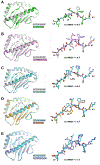Accurate modeling of peptide-MHC structures with AlphaFold
- PMID: 38113889
- PMCID: PMC10872456
- DOI: 10.1016/j.str.2023.11.011
Accurate modeling of peptide-MHC structures with AlphaFold
Abstract
Major histocompatibility complex (MHC) proteins present peptides on the cell surface for T cell surveillance. Reliable in silico prediction of which peptides would be presented and which T cell receptors would recognize them is an important problem in structural immunology. Here, we introduce an AlphaFold-based pipeline for predicting the three-dimensional structures of peptide-MHC complexes for class I and class II MHC molecules. Our method demonstrates high accuracy, outperforming existing tools in class I modeling accuracy and class II peptide register prediction. We validate its performance and utility with new experimental data on a recently described cancer neoantigen/wild-type peptide pair and explore applications toward improving peptide-MHC binding prediction.
Keywords: AlphaFold; T-cells; major histocompatibility complex; neoantigens; protein structure prediction.
Copyright © 2023 Elsevier Ltd. All rights reserved.
Conflict of interest statement
Declaration of interests A.J.L. is a founder, director, and shareholder and receives fees for these activities of PMV Pharma. He also is a consultant for Chugai Pharma and receives a fee for that position. Neither company works in the topic of this manuscript. V.M. is an employee and shareholder of BioNTech US, Inc.
Figures





Update of
-
Accurate modeling of peptide-MHC structures with AlphaFold.bioRxiv [Preprint]. 2023 Mar 8:2023.03.06.531396. doi: 10.1101/2023.03.06.531396. bioRxiv. 2023. Update in: Structure. 2024 Feb 1;32(2):228-241.e4. doi: 10.1016/j.str.2023.11.011. PMID: 36945436 Free PMC article. Updated. Preprint.
Similar articles
-
Accurate modeling of peptide-MHC structures with AlphaFold.bioRxiv [Preprint]. 2023 Mar 8:2023.03.06.531396. doi: 10.1101/2023.03.06.531396. bioRxiv. 2023. Update in: Structure. 2024 Feb 1;32(2):228-241.e4. doi: 10.1016/j.str.2023.11.011. PMID: 36945436 Free PMC article. Updated. Preprint.
-
pMHChat, characterizing the interactions between major histocompatibility complex class II molecules and peptides with large language models and deep hypergraph learning.Brief Bioinform. 2025 Jul 2;26(4):bbaf321. doi: 10.1093/bib/bbaf321. Brief Bioinform. 2025. PMID: 40619811 Free PMC article.
-
MHC-Fine: Fine-tuned AlphaFold for precise MHC-peptide complex prediction.Biophys J. 2024 Sep 3;123(17):2902-2909. doi: 10.1016/j.bpj.2024.05.011. Epub 2024 May 15. Biophys J. 2024. PMID: 38751115 Free PMC article.
-
Analysis of the structure of naturally processed peptides bound by class I and class II major histocompatibility complex molecules.EXS. 1995;73:105-19. doi: 10.1007/978-3-0348-9061-8_6. EXS. 1995. PMID: 7579970 Review.
-
Peptide binding by class I and class II MHC molecules.Biopolymers. 1997;43(4):281-302. doi: 10.1002/(SICI)1097-0282(1997)43:4<281::AID-BIP3>3.0.CO;2-R. Biopolymers. 1997. PMID: 9316393 Review.
Cited by
-
Structural and physical features that distinguish tumor-controlling from inactive cancer neoepitopes.Proc Natl Acad Sci U S A. 2023 Dec 19;120(51):e2312057120. doi: 10.1073/pnas.2312057120. Epub 2023 Dec 12. Proc Natl Acad Sci U S A. 2023. PMID: 38085776 Free PMC article.
-
Epitope mapping via in vitro deep mutational scanning methods and its applications.J Biol Chem. 2025 Jan;301(1):108072. doi: 10.1016/j.jbc.2024.108072. Epub 2024 Dec 14. J Biol Chem. 2025. PMID: 39674321 Free PMC article. Review.
-
RankMHC: Learning to Rank Class-I Peptide-MHC Structural Models.J Chem Inf Model. 2024 Dec 9;64(23):8729-8742. doi: 10.1021/acs.jcim.4c01278. Epub 2024 Nov 18. J Chem Inf Model. 2024. PMID: 39555889
-
A journey to your self: The vague definition of immune self and its practical implications.Proc Natl Acad Sci U S A. 2024 Jun 4;121(23):e2309674121. doi: 10.1073/pnas.2309674121. Epub 2024 May 9. Proc Natl Acad Sci U S A. 2024. PMID: 38722806 Free PMC article.
-
The power and pitfalls of AlphaFold2 for structure prediction beyond rigid globular proteins.Nat Chem Biol. 2024 Aug;20(8):950-959. doi: 10.1038/s41589-024-01638-w. Epub 2024 Jun 21. Nat Chem Biol. 2024. PMID: 38907110 Free PMC article. Review.
References
Publication types
MeSH terms
Substances
Grants and funding
LinkOut - more resources
Full Text Sources
Molecular Biology Databases
Research Materials

